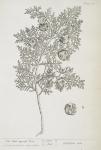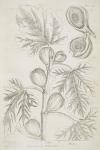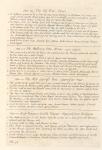1. It seldome grows to be a Tree of any great Bigness in England; the Leaves are a grass Green, and the Fruit when ripe of a brownish Green; it beareth no visible Flowers, which makes it believed they are hid in the Fruit.
2. Its Native soils are Turky, Spain and Portugal; and its time of Bearing is in Spring and Autumn; the Figs are cured by dipping them in scalding hot Lye, made of ye Ashes of the cuttings of the Tree, and afterwards they dry them carefully in the Sun.
3. Figs are esteem'd cooling and moistning, good for Coughs, shortness of Breath, and all Diseases of the Breast; as also the Stone and Gravel, and the small Pox and Mesels, which they drive out. Outwardly they are dissolving and ripening, good for Imposthumations and Swellings; and pestilential Buboes.
4. Greek, Σύκα. Latin, Ficus. Spanish, Igos. Italian, Fichi. French, Figues. German, Fengen. Dutch, Uygen.

 126. The Mulberry Tree. Morus. - nigra vulgaris.
126. The Mulberry Tree. Morus. - nigra vulgaris.
1. This grows to be a tall Tree, the Leves are a dark Green, the Flowers yellowish, and the Berries when ripe a dark Purple.
2. It grows in Gardens, and the Fruit is ripe in August and September.
3. The Bark of the Root is thought to warm and dry, opening obstructions of the Liver and Spleen, and helping the Jaundice. - The unripe Fruit is binding and drying, good in all kinds of Fluxes, and Inflammations of the Mouth and Throat. - The ripe Fruit is cooling, good to allay the Heat of Burning Febers, and create an Appetite.
4. Greek, Μορέα. Latin, Morus, & Morus arbor. Spanish, Moras del Moral. Italian, Moro. French, Maurier. German, Maulbeerbaum. Dutch, Moerbesien.

 127. The Male Cypress Tree. Cupressus mas.
127. The Male Cypress Tree. Cupressus mas.
1. This grows to be a tall Tree, but is not so much branch'd as the Female; the Leaves are a grass Green, the Flowers a dirty Yellow, & the Cones, which are rounder than ye Females, brown.
2. It grows wild in Creet: the Flowers come forth the Beginning of Summer, and ye Cones are ripe in Autumn.
3. The Cones are accounted drying and binding, good to stop spitting of Blood, Dyarrheas, Dysenteries, immoderate Flux of the Menses, involuntary Miction. - They likewise prevent the Bleeding of the Gums and fasten loose Teeth. - Outwardly they are used in stiptic Fomentations and Cataplasms.
4. Greek, Κυπάρισσος. Latin, Cupressus mas. Spanish, Cipres. Italian, Cipresso. French, Cypres. German, Cypressen. Dutch, Cypresse Boom.
(Henriette's comment: any plant that produces fruit is female. The "male" is Cupressus sempervirens var. fastigiata, the "female" is Cupressus sempervirens var. horizontalis.)

 128. Horse Tongue, or Double Tongue. Hippoglossum Bislingua.
128. Horse Tongue, or Double Tongue. Hippoglossum Bislingua.
Also see #128. Horse Tongue, or Double Tongue - #154. Kneeholm or Butcher's-broom - 194. The Bay of Alexandria
1. The Stalks grow five or Six Inches high, the Leaves are a deep Green, the Flowers whitish, and the Berrys red.
2. It grows wild in Italy, and flowers in Iune.
3. This Plant is esteem'd heating and drying, good for Disorders and Suffocations of the Womb, Hysteric Fits, hastening the Birth, expelling the After Birth, and procuring the Catamenia.
4. Greek, Ιππογλπωσσον. Latin, Bislingua, Hippoglossum. Spanish, Lengua de Cavallo. Italian, Bislingua or Bonifacia. French, Bislingua. German, XapfflinCraut. Dutch, .




